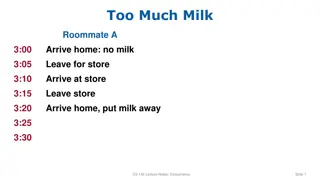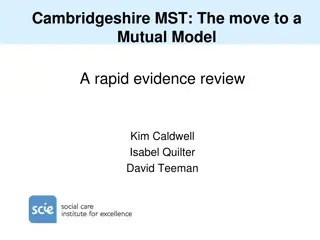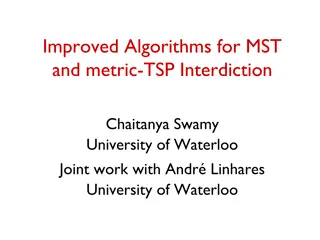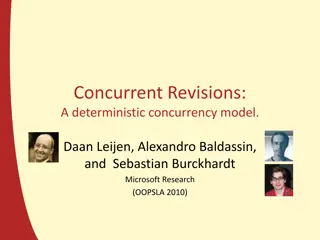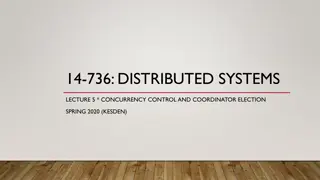
Concurrency and Minimum Spanning Trees in CSE 332 Lecture 24
Learn about concurrency and minimum spanning trees in CSE 332 Lecture 24, including synchronization in Java, reentrant locks, and the importance of proper locking in bank account operations.
Download Presentation

Please find below an Image/Link to download the presentation.
The content on the website is provided AS IS for your information and personal use only. It may not be sold, licensed, or shared on other websites without obtaining consent from the author. If you encounter any issues during the download, it is possible that the publisher has removed the file from their server.
You are allowed to download the files provided on this website for personal or commercial use, subject to the condition that they are used lawfully. All files are the property of their respective owners.
The content on the website is provided AS IS for your information and personal use only. It may not be sold, licensed, or shared on other websites without obtaining consent from the author.
E N D
Presentation Transcript
Wrap Concurrency Minimum Spanning Trees CSE 332 Sp25 Lecture 24
Announcements Monday Monday Veteran s Day Wed Wed TODAY TODAY Ex 13 (MST,prog) out Ex 13 due Thursday Thursday Friday Friday Ex 12 (concurrency, GS) due final conflict form due final conflict form due Ex 14 due Tuesday Tuesday Ex 11 (prefix prog)due This Week Ex 14 (P/NP, GS) out Next Week Final Exam information page is up. If you are requesting a conflict exam, please do so by Friday.
We said last time bank account should have 1 lock per object, not 1 lock per method that updates the balance. Show a bad interleaving when we have a lock for each method. Warm-Up class BankAccount{ private int balance = 0; private Lock lk = new Lock(); private Lock lk2 = new Lock(); void withdraw(int amount){ lk.acquire(); //might block int b = getBalance(); if(amount > b) { lk.release(); throw new WithdrawTooLargeException(); setBalance(b amount); lk.release(); } void deposit(int amount){ lk2.acquire(); int b = getBalance(); setBalance(b + amount); lk2.release(); }
Warm-up void withdraw(int amount){ lk.acquire(); //might block int b = getBalance(); if(amount > b) { lk.release(); throw new setBalance(b amount); lk.release(); } void deposit(int amount){ lk2.acquire(); int b = getBalance(); setBalance(b + amount); lk2.release(); } 4 5 6 7 1 2 3 8 9 This interleaving erases the deposit. If there were only one lock (just lk not lk2), this interleaving isn t possible!
Real Java locks A re-entrant lock is available in: java.util.concurrent.locks.ReentrantLock Methods are lock() and unlock()
synchronized Java has built-in support for reentrant locks with the keyword synchronized synchronized (expression) { //Critical section here } -Expression must evaluate to an Object. -Every object is a lock in java -Lock is acquired at the opening brace and released at the matching closing brace. (Java handles instantiating the lock, remembering which one is which, etc.) -Released even if control leaves due to throw/return/etc.
synchronized If your whole method is a critical section And the object you want for your lock is this You can change the method header to include synchronized. E.g. private synchronized void getBalance() Equivalent of having synchronized(this){ } around entire method body.
Multiple Locks What happens when you need to acquire more than one lock? What new thing could go wrong with this code? void transferTo(int amt, BankAccount a){ this.lk.acquire(); a.lk.acquire(); this.withdraw(amt); a.deposit(amt); a.lk.release(); this.lk.release(); }
Multiple Locks THREAD 1, FROM ACCT1 TO ACCT2 THREAD 2, FROM ACCT2 TO ACCT1 void transferTo( ){ this.lk.acquire(); a.lk.acquire(); this.withdraw(amt); a.deposit(amt); a.lk.release(); this.lk.release(); } void transferTo( ){ this.lk.acquire(); a.lk.acquire(); this.withdraw(amt); a.deposit(amt); a.lk.release(); this.lk.release(); } UH-OH! Thread 1 needs Thread 2 to let go, but Thread 2 needs Thread 1 to let go 1 2 blocks blocks
Deadlock Deadlock occurs when we have a cycle of dependencies i.e. we have threads ?1, ,?? such that thread ?? is waiting for a resource held by ??+1 and ?? is waiting for a resource held by ?1. How can we set up our program so this doesn t happen?
Deadlock Solutions Option 1: Smaller critical section: -Acquire bank account 1 s lock, withdraw, release that lock -Acquire bank account 2 s lock, deposit, release that lock Maybe ok here, but exposes wrong total amount in bank while blocking. Option 2: Coarsen the lock granularity -One lock for all accounts. -Probably too coarse for good behavior Option 3: All methods acquiring multiple locks acquire them in the same order. -E.g. in order of account number. More options take Operating Systems!
Conventional Wisdom There are three types of memory Thread local (each thread has its own copy) Immutable (no thread overwrites that memory location) Shared and mutable -Synchronization needed to control access. Whenever possible make memory of type 1 or 2. If you can minimize/eliminate side-effects in your code, you can make more memory type 2.
Conventional Wisdom Consistent locking: Every location that reads or writes a shared resource has a lock. Even if you can t think of a bad interleaving, better safe than sorry. When deciding how big to make a critical section: Start coarse grained (i.e., start with a very large critical section), and move finer if you really need to improve performance.
Conventional Wisdom Avoid expensive computations or I/O in critical sections. If possible release the lock, do the long computation, and reacquire the lock. Just make sure you haven t introduced a race condition. Think in terms of what operations need to be atomic. i.e. consider atomicity first, then think about where the locks go.
Conventional Wisdom Don t write your own. There s probably a library that does what you need. Use it. There are thread-safe libraries like ConcurrentHashMap. No need to do it yourself when experts already did it -and probably did it better.
A distinction A Race Condition Race Condition is an error in parallel code the output depends on the order of execution of the threads (who wins the race to be executed). We ll divide into two types A data race data race is an error where at (potentially) the same time: at (potentially) the same time: 1. Two threads are writing the same variable. 2. One thread writes to a variable while another is reading it. A Bad interleaving Bad interleaving Is when incorrect behavior (as defined by the user) could result from a particular sequential execution order. (We don t don t consider deadlock a race condition, but a separate kind of concurrency bug)
Huh? Consider this code class Stack<E>{ private E[] array = (E[])new Object[SIZE]; private int index = -1; synchronized public Boolean isEmpty() { return index==-1;} synchronized public void push(E val) {array[++index]=val;} synchronized public E pop() { if(isEmpty()) { throw new StackEmptyException(); } return array[index--]; } public E peek() { E ans = pop(); push(ans); return ans; } }
Whats the problem? That peek is, uh, interesting.. Certainly would work as sequential code (albeit probably bad style). But with multiple threads ? Well, there aren t any data races. synchronized. We only ever have one thread touching any data (the underlying array or index variable) at a time. But it certainly isn t correct! Peek has an intermediate state that (if exposed during a bad interleaving bad interleaving) leads to incorrect behavior. data races. The calls to push and pop are
Bad Interleaving 1 THREAD A (PEEK) THREAD B (PUSH + ISEMPTY) 2 1 E ans = pop(); push(ans); return ans; push(x); boolean b = isEmpty(); 4 5 3 Logical expectation: If we push (and haven t popped) then the stack is not empty. This is a bad interleaving, without a data race.
Bad Interleaving 2 THREAD A (PEEK) THREAD B (TWO PUSHES) E ans = pop(); push(ans); return ans; push(x); push(y); Logical expectation: Pushed values go in LIFO order
Bad Interleaving 2 THREAD A (PEEK) THREAD B (TWO PUSHES) 2 1 E ans = pop(); push(ans); return ans; push(x); push(y); 3 4 5 Logical expectation: Pushed values go in LIFO order This is a bad interleaving, without a data race. Notice, this interleaving would be fine if we just had a generic list!
Bad Interleaving 3 THREAD A (PEEK) THREAD B (TWO PUSHES, POP) E ans = pop(); push(ans); return ans; push(x); push(y); E e = pop(); Logical expectation: Popped values come in LIFO order
Bad Interleaving 3 THREAD A (PEEK) THREAD B (TWO PUSHES, POP) 3 1 E ans = pop(); push(ans); return ans; push(x); push(y); E e = pop(); 4 5 6 2 Logical expectation: Popped values come in LIFO order
Bad Interleaving 4 THREAD A (PEEK) THREAD B (PEEK) E ans = pop(); push(ans); return ans; E ans = pop(); push(ans); return ans; Logical expectation: Peek on a non-empty heap does not throw an exception
Bad Interleaving 4 THREAD A (PEEK) THREAD B (PEEK) 2 1 E ans = pop(); push(ans); return ans; E ans = pop(); push(ans); return ans; 3 4 5 6 Logical expectation: Peek on a non-empty queue does not throw an exception
The Fix: Dont allow interleaving! Peek needs synchronization Enlarge the critical section to be the whole method. Ensures no one is even looking at the stack until we push back the element we popped.
The Fix Problem so far: peek does writes, creating an intermediate state. The right fix: Make isEmpty and peek synchronized. It s tempting to try to fix the code like this (This is the wrong fix!): peek, if normally implemented (or isEmpty) doesn t actually write anything. Maybe we can skip the synchronization on those? Do NOT remove the synchronization from peek/isEmpty. You will create a data race! isEmpty reads the same data push writes (e.g., the index variable). That is definitionally definitionally a data race
We Cant Keep Getting Away With It It might look like isEmpty or peeknot being synchronized won t lead to errors. After all, that pushis just one line! I can t figure out how to make bad interleavings. Don t Don t think just because you can t figure out a bad interleaving that a data race won t be a problem. 1. single steps aren t always single steps. 2. A data race is an error by definition by definition. The compiler does a lot of optimizations (including reordering sequential code) assuming don t have data races. If you have them, your code may execute wrong. And good luck figuring that bug out..(see Grossman 7.2) assuming you
Summary Two kinds of race conditions: Data race (a thread potentially reads while another writes, or two potentially write simultaneously) Bad Interleaving: exposes intermediate state to other threads, leads to behavior we we find incorrect. Data races are never acceptable, even if you can t find a bad interleaving. Checking correctness is usually: 1. finding there are no data races, then 2. looking for bad interleavings.
Minimum Spanning Trees It s the 1920 s. Your friend at the electric company needs to choose where to build wires to connect all these cities to the plant. B 6 3 E 2 1 C 10 A 9 5 7 4 D 8 She knows how much it would cost to lay electric wires between any pair of locations, and wants the cheapest way to make sure electricity from the plant to every city.
Minimum Spanning Trees It s the 1920 s. Your friend at the electric company needs to choose where to build wires to connect all these cities to the plant. B 6 phone 1950 s boss phones to each other. 3 E 2 1 C 10 A 9 5 7 4 D F 8 phone She knows how much it would cost to lay electric wires between any pair of locations, and wants the cheapest way to make sure electricity from the plant to every city. Everyone can call everyone else.
Minimum Spanning Trees today ISP It s the 1920 s. Your friend at the electric company needs to choose where to build wires to connect all these cities to the plant. B 6 the Internet. 3 E 2 1 C 10 A 9 5 7 4 D 8 She knows how much it would cost to lay electric wires between any pair of locations, and wants the cheapest way to make sure Everyone can reach the server cable
Minimum Spanning Trees What do we need? A set of edges such that: -Every vertex touches at least one of the edges. (the edges span graph) -The graph on just those edges is connected -i.e. the edges are all in the same connected component. -A connected component is a vertex and everything you can reach from it. -The minimum weight set of edges that meet those conditions Claim: The set of edges we pick never has a cycle. Why? span the connected. connected component.
Aside: Trees On graphs our tees: -Don t need a root (the vertices aren t ordered, and we can start BFS from anywhere) -Varying numbers of children neighbors -Connected and no cycles Tree Tree (when talking about undirected graphs) (when talking about undirected graphs) An undirected, connected acyclic graph.
MST Problem What do we need? A set of edges such that: -Every vertex touches at least one of the edges. (the edges span -The graph on just those edges is connected -The minimum weight set of edges that meet those conditions. Our goal is a tree! Minimum Spanning Tree Problem Minimum Spanning Tree Problem span the graph) connected. Given Given: an undirected, (connected, simple) weighted graph G Find Find: A minimum-weight set of edges such that you can get from any vertex of G to any other on only those edges. We ll go through two different algorithms for this problem.
Example Try to find an MST of this graph: B 6 3 E 2 1 C 10 A 9 5 7 4 D F 8
Prims Algorithm Algorithm idea: choose an arbitrary starting point. Add a new edge that: -Will let you reach more vertices. -Is as light as possible We d like each not-yet-connected vertex to be able to tell us the lightest edge we could add to connect it.
Code PrimMST(Graph G) initialize distances to mark source as distance 0 mark all vertices unprocessed foreach(edge (source, v) ) { v.dist = weight(source,v) while(there are unprocessed vertices){ let u be the closest unprocessed vertex add u.bestEdge to spanning tree foreach(edge (u,v) leaving u){ if(weight(u,v) < v.cost){ v.cost = weight(u,v) v.bestEdge = (u,v) } } mark u as processed } }
50 G 6 Try it Out B E 2 3 4 C 5 PrimMST(Graph G) initialize distances to mark source as distance 0 //pick arbitrarily mark all vertices unprocessed foreach(edge (source, v) ) v.dist = w(source,v) while(there are unprocessed vertices){ let u be the closest unprocessed vertex add u.bestEdge to spanning tree foreach(edge (u,v) leaving u){ if(w(u,v) < v.cost){ v.cost = w(u,v) v.bestEdge = (u,v) } } mark u as processed } A 9 2 7 7 F D 8 Vertex Vertex Cost A B C D E F G Cost Best Edge Best Edge Processed Processed
50 G 6 Try it Out B E 2 3 4 C 5 PrimMST(Graph G) initialize distances to mark source as distance 0 mark all vertices unprocessed foreach(edge (source, v) ) v.dist = w(source,v) while(there are unprocessed vertices){ let u be the closest unprocessed vertex add u.bestEdge to spanning tree foreach(edge (u,v) leaving u){ if(w(u,v) < v.cost){ v.cost = w(u,v) v.bestEdge = (u,v) } } mark u as processed } A 9 2 7 7 F D 8 Vertex Vertex Cost A B C D E F G Cost -- 2 4 7 2 6 5 3 50 Best Edge Best Edge -- (A,B) (A,C) (A,D)(C,D) (B,E)(C,E) (B,F) (B,G) Processed Processed Yes Yes Yes Yes Yes Yes Yes
PrimMST(Graph G) initialize distances to mark source as distance 0 mark all vertices unprocessed //and add to priority queue foreach(edge (source, v) ) { v.dist = weight(source,v) while(there are unprocessed vertices){ let u be the closest unprocessed vertex //removeMin! add u.bestEdge to spanning tree foreach(edge (u,v) leaving u){ if(weight(u,v) < v.cost){ v.cost = weight(u,v) //updatePriority!! v.bestEdge = (u,v) } } mark u as processed } } Running time: (? log?) Analysis same as Dijkstra, but can assume ? ? 1
Some Exercise Notes We ll ask you to implement Prim s in Exercise 13. You have a few options for the priority queue: 1. Use a Java library priority queue---but it doesn t have updatePriority() so you ll need a workaround: A. Add edges instead of vertices to the priority queue OR B. Allow multiple copies of each vertex into the queue (instead of decreasing priority, put in a second copy at the new priority OR 2. Use your (Exercise 2) priority queue instead---call updatePriority! Will these change the running time? No! log ? = log ? for simple graphs. Read the paragraph in the spec about this before you get too far. Also see alternate version of pseudocode in section slides tomorrow.
Does This Algorithm Always Work? Prim s Algorithm is a greedy edge in the MST it never reconsiders its decision. Greedy algorithms rarely work. There are special properties of MSTs that allow greedy algorithms to find them. greedy algorithm. Once it decides to include an In fact MSTs are so magical that there s more than one greedy algorithm that works.
Why do all of these MST Algorithms Work? MSTs satisfy two very useful properties: Cycle Property: Cycle Property: The heaviest edge along a cycle is NEVER part of an MST. Cut Property: Cut Property: Split the vertices of the graph any way you want into two sets A and B. The lightest edge with one endpoint in A and the other in B is ALWAYS part of an MST. Whenever you add an edge to a tree you create exactly one cycle, you can then remove any edge from that cycle and get another tree out. This observation, combined with the cycle and cut properties form the basis of all of the greedy algorithms for MSTs.




